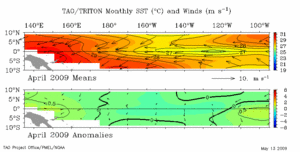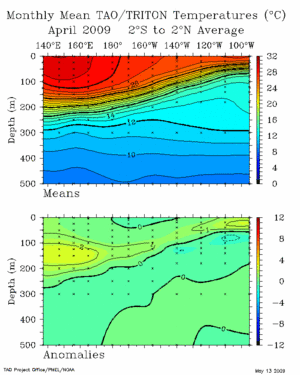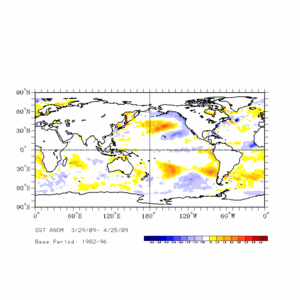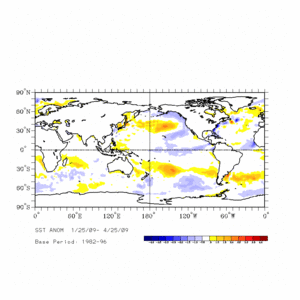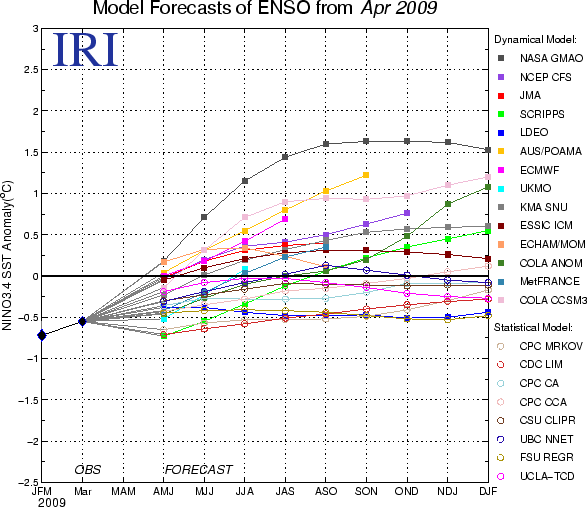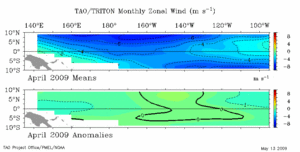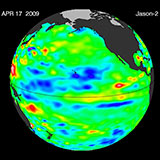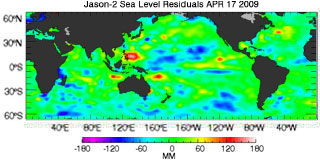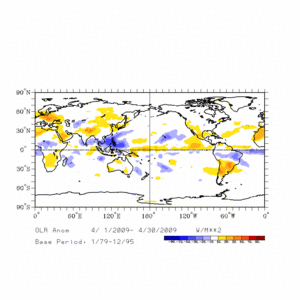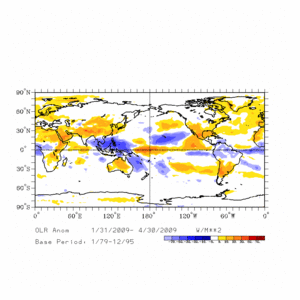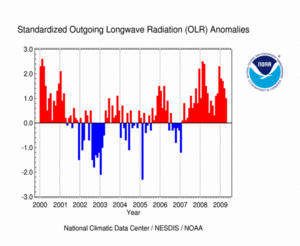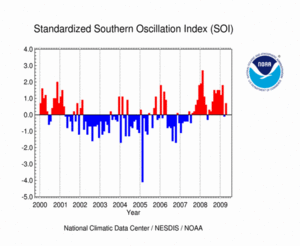Warming Tropical Pacific Brings Neutral Conditions
Sea Surface Temperatures (SSTs) and Mixed Layer Conditions:
Sea surface temperatures (SST) across the central and eastern tropical Pacific continued to warm, as they have since February. The SST anomalies of all four Niño regions experienced warming in April relative to March. The SST anomalies in the Niño 3 and Niño 4 regions were near 0° while the Niño 1+2 region was 0.52°C (0.94°F) above normal. The Niño 3.4 area-averaged SST was -0.18°C (-0.32°F) below normal; but that anomaly was 0.30°C (0.54°F) warmer than it was in March.
For the most recent equatorial Pacific Ocean surface temperatures, please visit NOAA's Tropical Atmosphere Ocean (TAO) project and for weekly or monthly Niño region average SST and anomaly values, visit Climate Prediction Center's Atmospheric and SST Index values page.
Subsurface oceanic heat content anomalies continued to warm through April and were positive for the first time since mid-August 2008. The eastward spread of above-average temperatures near thermocline depth replaced most of the anomalously cool sub-surface water in the central and eastern tropical Pacific that had persisted since September of last year.
Niño 3.4 region SST anomalies experienced warming in April, relative to March, but the latest three-month (February-March-April) SST anomaly running mean (-0.5°C [-0.9°F]) reached the Oceanic Niño Index (ONI) La Niña conditions threshold of -0.5°C (-0.9°F) for the fourth consecutive month (NOTE: For NOAA's official ENSO classification scheme, please see NOAA's El Niño/La Niña Index Definition). Five consecutive values at or below this threshold constitutes a La Niña episode. A fifth month is not expected and both the Climate Prediction Center and the Australian Bureau of Meteorology have deemed April conditions "ENSO-neutral".
The majority of dynamic computer models show that ENSO-neutral conditions will continue through the remainder of 2009. Based on current observations, recent trends, and model forecasts, ENSO-neutral conditions are expected to continue at least through the boreal summer.
Equatorial Zonal Winds (U-Component Winds) and Sea-Level Topography:
Trade winds have weakened further again this month, and are now widely weaker than average. Collectively, these oceanic and atmospheric anomalies are consistent with a transition to ENSO-neutral conditions.
Pacific sea levels measured by the NASA/JPL Jason satellite reflected ENSO-neutral conditions across the tropical Pacific Ocean in April. Much of the central equatorial Pacific was near normal during the month. The positive anomalies that have been present in the far western Pacific region have deminished.
Outgoing Longwave Radiation (OLR):
Outgoing Longwave Radiation (OLR) values decreased for the fourth consecutive month, from +1.4 Wm-2 in March to +1.0 Wm-2 in April. The map below on the left shows the spatial pattern of global OLR (in Wm-2) measured by satellite during April. The lack of convection along the Equator near the Date Line has persisted since the development of the cold event in late May 2007.
The monthly OLR anomaly for April marked the 27th consecutive month that the OLR index had a positive monthly value. Persistently high positive OLR indices are typical of the mature phase of a La Niña episode, while negative values indicate the presence of increased convection and warm phase conditions.
High frequency variability in OLR is typically associated with the Madden-Julian Oscillation (MJO), which is convective activity that propagates west to east in the near-equatorial region from the Indian Ocean into the Pacific Ocean approximately every 30-60 days. The latest MJO activity can be seen in CPC's graphs of Daily MJO Indices.
Southern Oscillation Index (SOI):
The Southern Oscillation Index (SOI) returned to positive for the month of April—the negative value in March was the first negative SOI value in nine months. The standardized monthly averaged value rose from -0.1 in March to +0.7 in April.
Additional Links
- ENSO Monitoring
- NOAA El Niño / La Niña Index Definition
- NOAA's Pacific Marine Environmental Laboratory (PMEL):
- NOAA's Climate Prediction Center (CPC):
- NOAA's Physical Science Laboratory
- NASA/JPL Ocean Surface Topography from Space
- Australian Bureau of Meteorology (BoM) Climate Driver Update
- IRI - International Research Institute
 NOAA's National Centers for Environmental Information
NOAA's National Centers for Environmental Information
